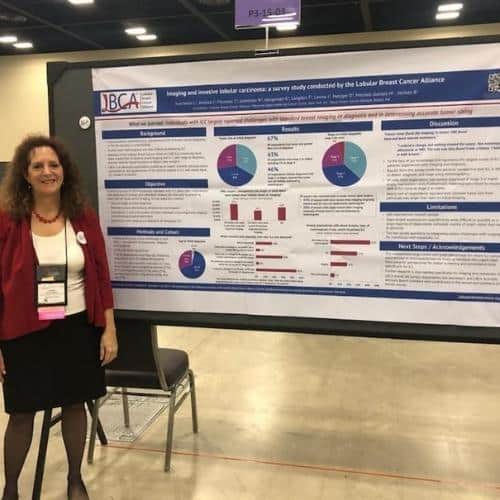The Lobular Breast Cancer Alliance (LBCA) presented its research poster, Imaging and invasive lobular carcinoma: A survey study conducted by the Lobular Breast Cancer Alliance, at the San Antonio Breast Cancer Symposium (SABCS) on December 9, 2021.

The poster shared the results of an online survey of individuals who had been diagnosed with invasive lobular carcinoma (ILC), also known as lobular breast cancer. LBCA wanted to better understand the experiences of patients with ILC with detection of primary and metastatic disease and to shed more light on issues of ILC imaging.
In presenting the poster and its purpose, LBCA Executive Director Laurie Hutcheson explained how common it is to hear, “My tumor was missed on imaging” expressed by women diagnosed with ILC. Laurie noted, “As patient advocates with lobular breast cancer, we know that lobular tumors, which comprise about 15% of breast cancer diagnosed annually, do not typically present or behave like the more common ductal carcinomas.”
She continued, “Because of the lack of the protein E-cadherin, lobular tumors do not clump together in a mass. It has been our experience that mammograms and other imaging does not always seem to identify lobular tumors at all or only when they are larger. Often, post-surgery pathology further reveals that there are more and larger lobular tumors than detected with imaging, and in some cases they have metastasized.”
The survey, which was issued in June, included questions about the size and stage of tumors at initial diagnosis, whether tumors were initially detected by mammogram, discrepancy in size and number of tumors between initial imaging and surgical specimens, and experience with imaging and detection of metastatic ILC.
LBCA received 1,476 survey responses with 1,000 coming within the first 24 hours. Most respondents were from the U.S. with respondents from 35 additional countries.
Survey Findings
Survey results supported the perception that there are many issues with imaging and ILC. It included the findings that:
- 67% of respondents reported having had tumors greater than 2 cm at diagnosis
- 63% reported that they were stage 2 or higher with 5% at stage 4 (metastatic) at diagnosis
- 46% of those initially diagnosed with tumors at stage 2 or higher indicated their tumor had NOT been detected by mammogram
- Additionally, a significant proportion of women who reported more or larger tumors post-surgery also indicated that their lobular breast cancer had not been detected by mammogram
The results of the survey convey that it is a typical experience of patients that ILC is difficult to detect, diagnose, and stage using mammography. The significant and rapid response to our survey suggested there are many who want this issue with ILC and imaging to be publicized.
LBCA concluded that the survey results support the need for development of better screening and surveillance tools that are specifically effective with ILC. Further, research is also needed specifically on imaging and metastatic ILC. LBCA hopes that our survey and findings provide some impetus for this to occur.
LBCA thanks study authors and patient advocates Janice Axelrod, Gitte Joergensen, Dr. Theresa Langdon, Julia Katherine Levine, and Barbara Neilsen. Additional authors include LBCA Scientific Advisory Board members Dr. Maxine Jochelson and Dr. Otto Metzger as well as LBCA staff Laurie Hutcheson, Mason Mitchell-Daniels, and Colleen Fitzwater.
LBCA thanks all survey respondents and volunteers, including Dr. Tracy Cushing and Ann Camden, who contributed to the design and synthesis of survey results.
The poster abstract appeared in AACR’s Cancer Journal in February 2022.

